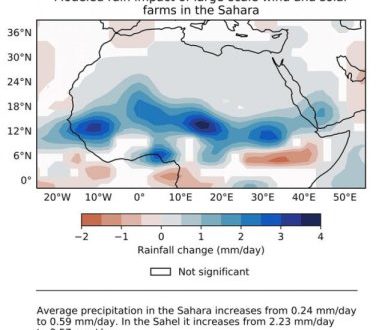Wind and solar farms are known to have local effects on heat. humidity and other factors that may be beneficial — or detrimental — to the regions in which they are situated. A new climate-modeling study finds that a massive wind and solar installation in the Sahara Desert and neighboring Sahel would increase local temperature. precipitation and vegetation. Overall. the researchers report. the effects would likely benefit the region.
The study. reported in the journal Science. is among the first to model the climate effects of wind and solar installations while taking into account how vegetation responds to changes in heat and precipitation. said lead author Yan Li. a postdoctoral researcher in natural resources and environmental sciences at the University of Illinois.
`Previous modeling studies have shown that large-scale wind and solar farms can produce significant climate change at continental scales.` Li said. `But the lack of vegetation feedbacks could make the modeled climate impacts very different from their actual behavior.
The new study. co-led with Eugenia Kalnay and Safa Motesharrei at the University of Maryland. focused on the Sahara for several reasons. Li said.
`We chose it because it is the largest desert in the world. it is sparsely inhabited. it is highly sensitive to land changes. and it is in Africa and close to Europe and the Middle East. all of which have large and growing energy demands.` he said.
The wind and solar farms simulated in the study would cover more than 9 million square kilometers and generate. on average. about 3 terawatts and 79 terawatts of electrical power. respectively.
`In 2017. the global energy demand was only 18 terawatts. so this is obviously much more energy than is currently needed worldwide.` Li said.
The model revealed that wind farms caused regional warming of near-surface air temperature. with greater changes in minimum temperatures than maximum temperatures.
`The greater nighttime warming takes place because wind turbines can enhance the vertical mixing and bring down warmer air from above.` the authors wrote. Precipitation also increased as much as 0.25 millimeters per day on average in regions with wind farm installations.
`This was a doubling of precipitation over that seen in the control experiments.` Li said. In the Sahel. average rainfall increased 1.12 millimeters per day where wind farms were present.
`This increase in precipitation. in turn. leads to an increase in vegetation cover. creating a positive feedback loop.` Li said.
Solar farms had a similar positive effect on temperature and precipitation. the team found. Unlike the wind farms. the solar arrays had very little effect on wind speed.
`We found that the large-scale installation of solar and wind farms can bring more rainfall and promote vegetation growth in these regions.` Kalnay said. `The rainfall increase is a consequence of complex land-atmosphere interactions that occur because solar panels and wind turbines create rougher and darker land surfaces.
`The increase in rainfall and vegetation. combined with clean electricity as a result of solar and wind energy. could help agriculture. economic development and social well-being in the Sahara. Sahel. Middle East and other nearby regions.` Motesharrei said.
 Iran Energy News Oil, Gas, Petrochemical and Energy Field Specialized Channel
Iran Energy News Oil, Gas, Petrochemical and Energy Field Specialized Channel




